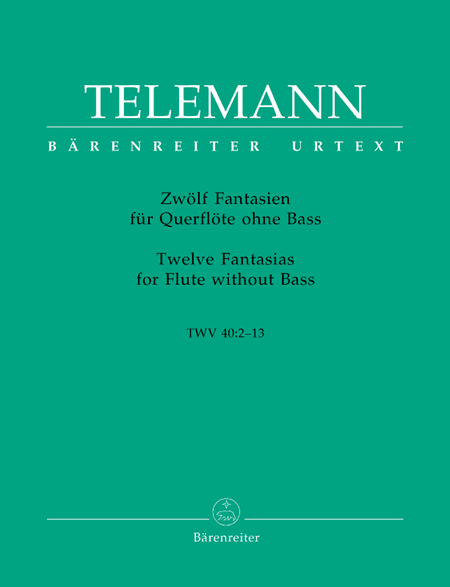10 /10 1 Votes
| 5/5 Sheet Music Plus | |||||||||||||||||||||||||||||||||
 | ||||||||||||||||||||||||||||||||||
Similar Piano Adventures, The flute book, The 36 Fantasias for Keybo, Duo for Flute and Piano, Music for a Mixed Taste: Sty | ||||||||||||||||||||||||||||||||||
Georg Philipp Telemann's 12 Fantasias for Solo Flute, TWV 40:2–13, were published in Hamburg in 1732–33. This is one of Telemann's collections of music for unaccompanied instruments, the others being thirty-six fantasias for solo harpsichord published in Hamburg in 1732–33, twelve for solo violin published in 1735, as well as a set of twelve fantasias for solo viola da gamba which was published in the same city in 1735, and were lost until 2015, but were rediscovered in a private music library by musicologist and viola da gamba performer Thomas Fritzsch.
This work comprises the following:
- Fantasia in A major (Vivace—Allegro)
- Fantasia in A minor (Grave—Vivace—Adagio—Allegro)
- Fantasia in B minor (Largo—Vivace—Largo—Vivace—Allegro)
- Fantasia in B-flat major (Andante—Allegro—Presto)
- Fantasia in C major (Presto—Largo—Presto—Dolce—Allegro—Allegro)
- Fantasia in D minor (Dolce—Allegro—Spirituoso)
- Fantasia in D major (Alla francese—Presto)
- Fantasia in E minor (Largo—Spirituoso—Allegro)
- Fantasia in E major (Affettuoso—Allegro—Grave—Vivace)
- Fantasia in F-sharp minor (A Tempo giusto—Presto—Moderato)
- Fantasia in G major (Allegro—Adagio—Vivace—Allegro)
- Fantasia in G minor (Grave—Allegro—Grave—Allegro—Dolce—Allegro—Presto)
The collection is arranged by key, progressing more or less stepwise from A major to G minor. Telemann deliberately avoided keys that are impractical on the one-key flute, i.e. B major, C minor, F minor and F-sharp major. There are two ways to view the overall structure of the collection: one way, in which the work is divided into two parts, is suggested by the fact that Fantasia 7 begins with a French overture, indicating a start of a new section. This device was also later used by Johann Sebastian Bach in Variation 16 of his Goldberg Variations. Another was proposed by scholar Wolfgang Hirschmann—there are four modal groups of three fantasias: major-minor-minor, major-major-minor, major-minor-major, and minor-major-minor.
Telemann's solo flute fantasias are alone in the entire Baroque repertoire to include movements seemingly impossible on flute: fugues (fantasias 2, 6, and 8–11), a French overture (fantasia 7) and a passacaglia (fantasia 5). The only manuscript available, in the library of the Royal Conservatory of Brussels, is entitled "Fantasie per il violino senza basso". Even though the more limited tessitura and the writing style (e.g. the absence of double stops and chords) refer to a score for traverso, it is more than likely that the fantasias were performed on the violin as well. In 2012, an arrangement for viola solo was published by Euprint. In this arrangement, through the use of double stops, some many-voiced parts appear as real polyphonic pieces.
